The pomegranate belongs to the essential symbols of the Eleusinian Mysteries and is intimately identified with Persephone. When Zeus ordered Hades to allow Kore to return to her mother Demeter, the one with the dark robe, the lord of the Underworld gave her “stealthily, the delicious berry of the pomegranate to eat” to ensure that she would not stay forever at the side of her honourable mother. Persephone tasted the “honey-sweet fruit” and was eternally condemned to spend a portion of the year in the “realms of dark mist underneath”.
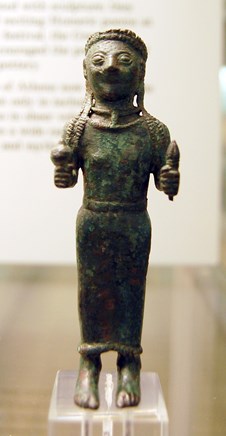
Bronze figure of a woman with a torch and a pomegranate, perhaps the goddess Persephone, 560 BCE, sculpture, The British Museum © The Trustees of the British Museum
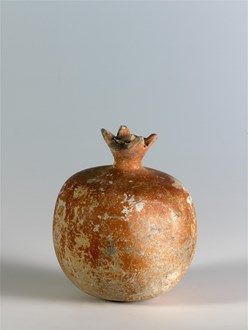
Pomegranate, 7th-6th century BCE, sculpture, Berlin State Museums (SMB) © Staatliche Museen zu Berlin, Antikensammlung / CC BY-SA 4.0
Ancient Greeks associated the multitude of pomegranate seeds with the virility of the living and the fertility of the fields. It was a common dedication to the sanctuaries of deities connected to fecundity such as Hera (Argos, Samos) and Aphrodite (marble pomegranates have been found at her sanctuary in Daphni). Beginning in the second half of the sixth century BCE, offering a pomegranate to a beloved served to bind the donor and the recipient with unshakable bonds. In various departing warrior or lover scenes in ancient Greek vases, we see this gesture to ensure that the beneficiary would feel sort of obligated to come back or remain next to the person giving the pomegranate.
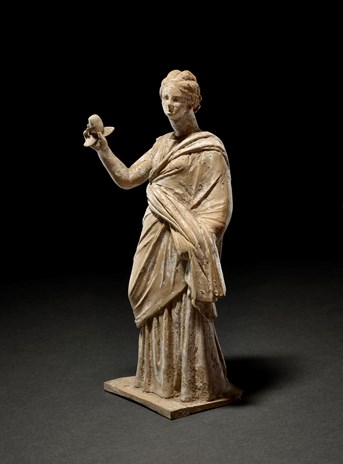
Terracotta figure of a woman (Persephone?) standing, her right hand (raised) holding a pomegranate, 275 BCE, sculpture, The British Museum © The Trustees of the British Museum
The vibrant red colour of the seeds bore a strong resemblance to blood and contributed to the association of the fruit with the world of the dead. Clement of Alexandria preserved a mythological tradition according to which the pomegranate sprang from the drops of the blood of Dionysus. On the tomb of Polynices grew a pomegranate whose fruit bled when plucked. The pomegranate fruit was often included in the offerings that accompanied the dead. Pomegranates adorn funerary stelae and appear on the white lekythoi as fruit given to the departed.
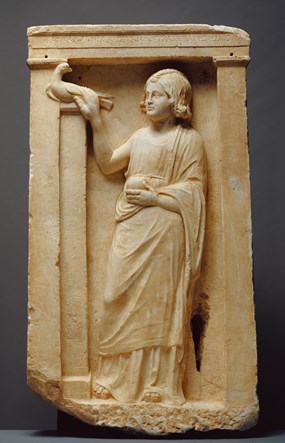
Grave naiskos of Apollonia [Apollonia holds a pomegranate], ca. 100 BCE, γλυπτό, The J. Paul Getty Museum © The J. Paul Getty Museum, Villa Collection, Malibu, California
The worship of the Eleusinian goddesses was connected to the fertility of the land and death. It was, therefore, only natural that the pomegranate would appear in the conventional iconography of the Mysteries. In addition, statues, and vases from across the ancient Greek world often depict Persephone holding the fruit. Surprisingly, though, the pomegranate is relatively rare in the sanctuary in Eleusis. No sculpture or vase shows the goddesses grasping a pomegranate. Archaeologists found clay pomegranates in tombs dating to the Geometric period, but there is no apparent connection to the Mysteries. The only exception is a gold pomegranate from the seventh century BCE that was found among the ashes of a ceremonial fire in the sanctuary, as well as a small black clay tablet that depicts Persephone holding a pomegranate branch.
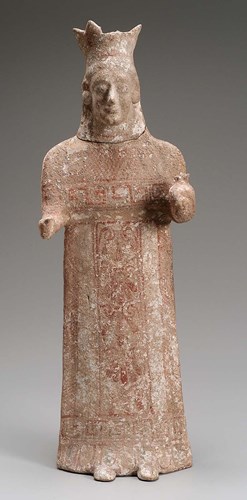
Statuette of Persephone or Hera holding a pomegranate, 500 BCE, sculpture, Boston Museum of Fine Arts © Boston Museum of Fine Arts
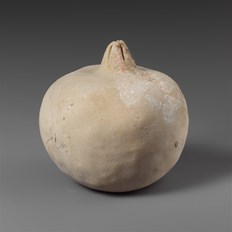
Terracotta pomegranate, 5th–4th century BCE, The Metropolitan Museum of Art © 2000–2023 The Metropolitan Museum of Art / Public domain
The chthonic character of pomegranate in Eleusis is evident in the limitation or prohibition of its consumption during the festivals of Demeter and Persephone. Women could eat pomegranate during the Thesmophoria festival, but any seeds that fell to the ground were off-limits since they belonged to the residents of the Underworld.
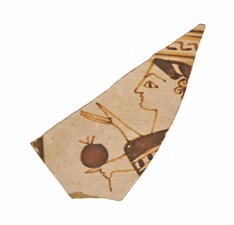
Chalice: Female figure holding a pomegranate, 570-560 BCE, αγγείο, The British Museum © The Trustees of the British Museum
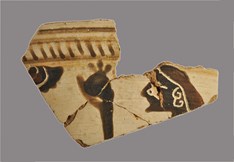
Chalice: Female figure holding a pomegranate, 560-550 BCE, αγγείο, The British Museum © The Trustees of the British Museum












